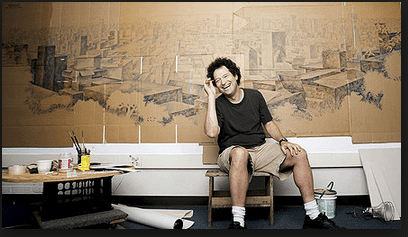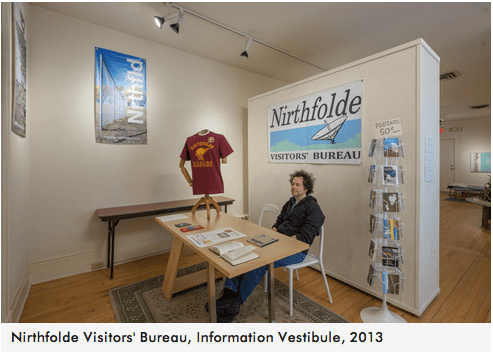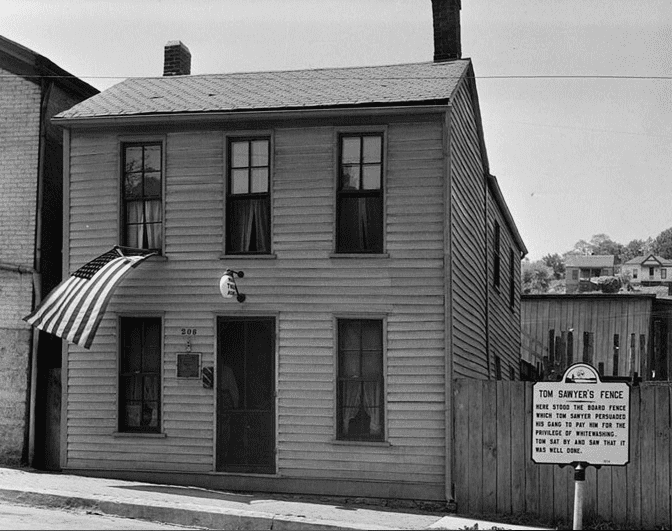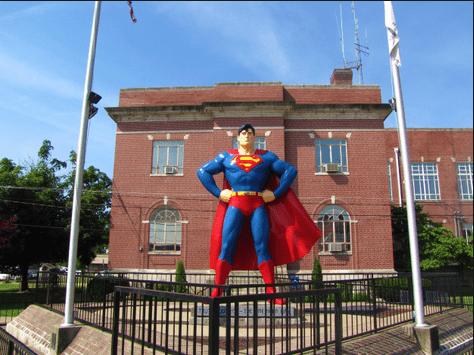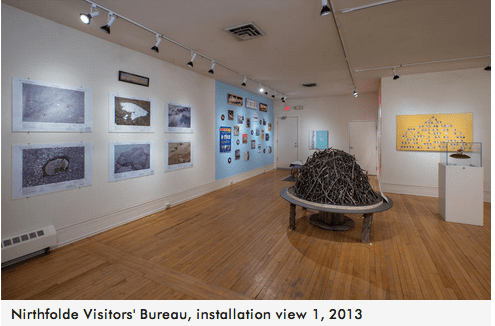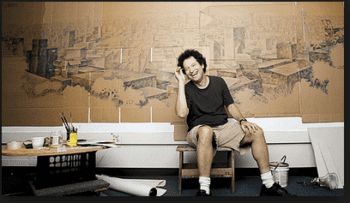
The New York Comics & Picture-Story Symposium is a weekly forum for discussing the tradition and future of text/image work. Open to the public, it meets Monday nights at 7-9pm EST in New York City. Presentations vary weekly and include everything from historical topics and technical demonstrations to creators presenting their work. Check out upcoming meetings here.
David Lefkowitz is an artist and professor at Carleton College in Northfield, Minnesota. Though not a cartoonist or comic artist, Lefkowitz is an installation and mixed-media artist and an adept storyteller. He concentrates on fact versus fiction in the world and questions how narrative plays into life. He’s curious about why we hold the immediate direct experience over the indirect experience, and he questions that further in his work.
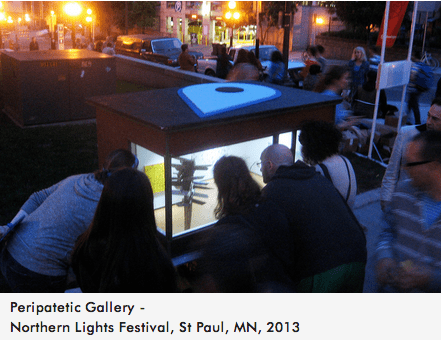 One of the pieces Lefkowitz talks about, the Peripatetic Gallery, is a moving dollhouse-sized work that pushed around to different display sites in St. Paul. This let him explore how people respond to an art exhibit that actually comes to them and what it means to have an art experience removed from the space of an art gallery. He questions if people view the gallery differently if they are the ones looking in, instead of looking around. The visitors are given a chance to have both a direct experience by looking at the gallery and an indirect one because they are just allowed one view of the gallery from the outside.
One of the pieces Lefkowitz talks about, the Peripatetic Gallery, is a moving dollhouse-sized work that pushed around to different display sites in St. Paul. This let him explore how people respond to an art exhibit that actually comes to them and what it means to have an art experience removed from the space of an art gallery. He questions if people view the gallery differently if they are the ones looking in, instead of looking around. The visitors are given a chance to have both a direct experience by looking at the gallery and an indirect one because they are just allowed one view of the gallery from the outside.
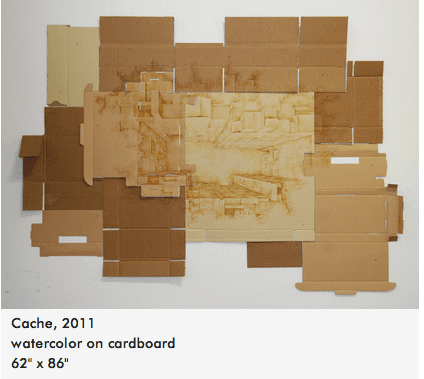 Another work mentioned in the talk was Cache, a watercolor drawing of cardboard packing boxes done on actual cardboard. Through this paradox of using the drawing of materials on the same material, Lefkowtiz questions the reality of material. Does seeing cardboard boxes on cardboard boxes give viewers a direct experience, or are they indirectly experiencing the cardboard box because they saw the watercolor on the boxes first?
Another work mentioned in the talk was Cache, a watercolor drawing of cardboard packing boxes done on actual cardboard. Through this paradox of using the drawing of materials on the same material, Lefkowtiz questions the reality of material. Does seeing cardboard boxes on cardboard boxes give viewers a direct experience, or are they indirectly experiencing the cardboard box because they saw the watercolor on the boxes first?
The focus of the talk was on Lefkowitz’s large, environmental installation in Northfield Minnesota’s art gallery. Inside the gallery, he created the Nirthfolde Visitors’ Bureau. Through this installation, Lefkowitz wanted to explore various ideas of authenticity and phoniness. He explained the different channels or “cases” that allowed him to explore this authentic experience.
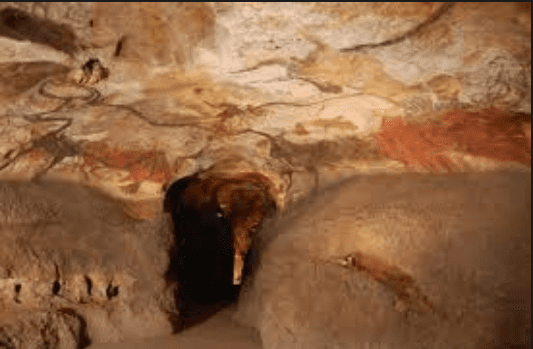 The first case brought to his attention is the inability to get to an actual historical place, requiring the fabrication of one instead. Lefkowitz gave the example of the Lascaux caves in France with their famous thirty-thousand-year-old paintings. Visitors enter not the real caves but rather lookalike caves right next to the real ones.
The first case brought to his attention is the inability to get to an actual historical place, requiring the fabrication of one instead. Lefkowitz gave the example of the Lascaux caves in France with their famous thirty-thousand-year-old paintings. Visitors enter not the real caves but rather lookalike caves right next to the real ones.
Case two concerns historical places that have incorporated fictional dialogue. For instance, Samuel Clemens’s home is historically marked within the town that he was born and grew up in. However, Huck Finn, the character that Clemens created as Mark Twain, is also all over the town. Lefkowitz shows the different spots in the town that are marked as Tom Sawyer or Huck Finn’s home or important locations in the fictional story as if these characters were real people.
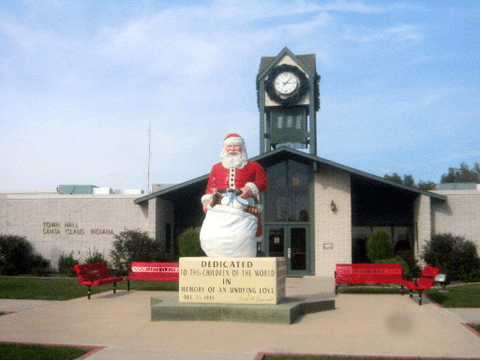 Lefkowitz also explored towns that showcase and exploit their mythical associations with their names. As an example, he cited Santa Claus, Indiana, which features the jolly character all over town, even though—cover your children’s ears—the man flying across the sky and landing on rooftops is completely fake. Santa Claus, Indiana, is just trying to create revenue and build their own potential as a city, Lefkowitz argues, as are many other towns.
Lefkowitz also explored towns that showcase and exploit their mythical associations with their names. As an example, he cited Santa Claus, Indiana, which features the jolly character all over town, even though—cover your children’s ears—the man flying across the sky and landing on rooftops is completely fake. Santa Claus, Indiana, is just trying to create revenue and build their own potential as a city, Lefkowitz argues, as are many other towns.
The final case is that of an actual place exploiting the fictional. The example of Metropolis, Illinois, provoked a few laughs when Lefkowitz called up an image of Superman standing in front of a small town hall. Lefkowitz points out the irony that Metropolis, Illinois, is less like the large city that we’re familiar with from comic books and more like the place where Clark Kent grew up. Lefkowitz added that Metropolis, Illinois, reminded him of another small town. At that point, a slide of Northfield, Minnesota, popped up, and again, a few chuckles went around the room.
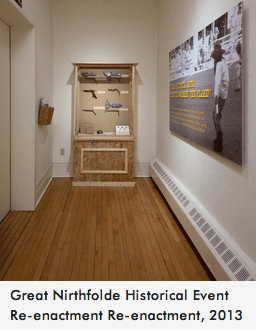 Getting back to the exhibit, Lefkowitz explained what he had done back in his town of Northfield. In the gallery space, he created a fictional town named Nirthfolde. Nirthfolde is a copy of Northfield and exploits the real town’s events and scenery as Nirthfolde’s own. As Lefkowitz explained, Northfield is known for a raid by the Jesse James gang, and the town holds an annual festival with reenactments of the raid. Consequently, for the exhibit, Lefkowitz displayed his own take on the raid with a fictional historical event involving a raider, complete with pictures of a celebration surrounding it. Lefkowitz also recreated a display from the historical museum down the block from the art gallery using easy-to-get materials. To have a bit more fun, he created postcards to sell of the fictional Nirthfolde. He exploits both the fictional city and authentic city through storytelling devices. Lefkowitz also emphasizes the role that museums or historical venues play in shaping the minds that come into them.
Getting back to the exhibit, Lefkowitz explained what he had done back in his town of Northfield. In the gallery space, he created a fictional town named Nirthfolde. Nirthfolde is a copy of Northfield and exploits the real town’s events and scenery as Nirthfolde’s own. As Lefkowitz explained, Northfield is known for a raid by the Jesse James gang, and the town holds an annual festival with reenactments of the raid. Consequently, for the exhibit, Lefkowitz displayed his own take on the raid with a fictional historical event involving a raider, complete with pictures of a celebration surrounding it. Lefkowitz also recreated a display from the historical museum down the block from the art gallery using easy-to-get materials. To have a bit more fun, he created postcards to sell of the fictional Nirthfolde. He exploits both the fictional city and authentic city through storytelling devices. Lefkowitz also emphasizes the role that museums or historical venues play in shaping the minds that come into them.
The role of the curator is to create a story to help patrons understand what the material on view is about. Lefkowitz explains this curatorial storytelling device by showing more examples of false exhibits, including the Museum of Jurassic Technology in California. The curator of this museum lives behind the museum in a trailer and loves museums. Though the Museum of Jurassic Technology is an actual museum, it is more noted for its display and the information that is presented by its curator. It is from this love that one can truly parody an object,genre, or place. Lefkowtiz acknowledges that there are mean-spirited parodies, but he does not adhere to that in his own work, nor do the people that he admires.
David Lefkowtiz’s work and talk delved into a storytelling aspect of display. His love for the work and the small town that he lives in is apparent in his Visitors’ Bureau. Lefkowitz may speak about the bigger abstract ideas of the real and the counterfeit, but his heart and body are grounded in the small town of Northfield, Minnesota.
Images
Image 1 – From David Lefkowtiz’s personal website, photograph of the artist.l
Image 2 – David Lefkowtiz, Peripatetic Gallery, 2013
Image 3 – David Lefkowtiz, Cahe, 2013
Image 4 – David Lefkowtiz, Nirthfolde Visitors’ Bureau, Information Vestibule, 2013
Image 5 – Lascaux Caves, North Wall, c. 15,000 BCE
Image 6 – Tom Sawyer’s House of Hannibal, Missouri
Image 7 – Town Hall of Santa Claus, Indiana
Image 8 – Town Hall of Metropolis, Illinois
Image 9 – David Lefkowtiz, Nirthfolde Visitors’ Bureau, Great Nirthfolde Historical Event Re-enactment Re-enactment, 2013
Image 10 – David Lefkowtiz, Nirthfolde Visitors’ Bureau, installation view, 2013
About the author: Emily Decker is a graduate student at Pratt Institute working towards a dual masters in art history and library and information sciences.

